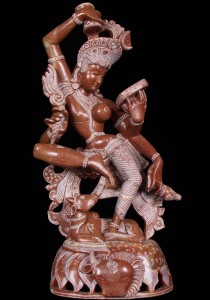
Shiva as Ardhanari, or Ardhanarishvara, translates to ‘Lord who is half woman.’ Ardhanarishvara is the androgynous combination of Shiva and his consort Parvati, split down the middle as half man half woman. Shiva, usually depicted on the right, is often adorned with headdress of a half crescent moon, serpent earring, third eye upon the center of his forehead, and wears a sacred thread across his chest. Parvati down the left is commonly portrayed with basket shaped crown, kundala earing, red dot matching Shiva’s third eye, and multi-colored or white linen dress. Visually, Shiva and Parvati embody their corresponding gender vigorously so as to starkly contrast their opposing counterpart.
Ardhanarishvara is said to characterize the fusion of the masculine and feminine energies of the world and exemplifies how Shakti, the female principle of God, is inseparable from Shiva, the male principle of God. The merger between these masculine and feminine energies is regarded as the root of all creation.
God is both Shiva and Parvati, “both male and female, both father and mother, both aloof and active, both fearsome and gentle, both destructive and constructive” and unifies all other oppositions of the universe.
It is believed that Parvati is not just Shiva’s consort, but an actual part of him.
Ardhanari is one of the most popularly worshiped forms of Shiva and can be found in virtually every temple or shrine throughout India and south-east Asia. It is often regarded that the ultimate goal of a devotee is to be united with Shiva as Parvati is in the Ardhanarishvara form.
